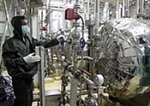
 |
| Preventing Nuclear Terrorism | |
|
Washington, D.C. 25 October 2006 |
Nuclear materials have a wide range of characteristics. Enriched uranium or plutonium have awesome explosive potential. Cesium emits deadly radiation, while isotopes of some radioactive substances, such as thallium, can be safely injected into patients undergoing medical procedures. Any kind of nuclear material in the hands of terrorists could have serious security implications.
Nuclear energy is a double-edged sword.
Contained in the controlled environment of a nuclear power plant, it
can generate electricity to run entire cities. Unleashed in a bomb
blast, nuclear energy can destroy a metropolis.
The catastrophic
consequences of such an explosion have prompted U.N. Secretary-General
Kofi Annan to call nuclear terrorism one of the most urgent threats of
our time. "Even one such attack could inflict mass casualties and
change our world forever. That prospect should compel all of us to do
our part to strengthen our common defenses," says Annan.
Nuclear Safeguards
Last year, 91 nations signed the U.N.
International Convention for the Suppression of Acts of Nuclear
Terrorism. The convention prohibits individuals from possessing
radioactive material with the intention of causing death or serious
bodily injury. But some countries have weak nuclear safeguards.
Paul
Leventhal, founder of the non-governmental Nuclear Control Institute in
Washington, D.C. says terrorists could exploit such weakness. "The
states today that we're most worried about in terms of assisting
terrorist organizations are Iran and North Korea,"
says Leventhal. "If they were able to acquire fissile
material, not necessarily from the state apparatus itself, but one or
two entrepreneurial physicists like A. Q. Khan of Pakistan, and I think
you also have to include Pakistan also as a potential supplier of
terrorist organizations."

An Iranian nuclear facility in Isfahan
A.Q. Khan, or Abdul Qadeer Khan, is
the developer of Pakistan's nuclear bomb. He is under house arrest in
that nation for selling nuclear technology to North Korea and Iran.
Pakistan denies any prior knowledge of the transfer, but Khan remains a
national hero. A member of Pakistan's Cabinet, Sheikh Rashid Ahmad,
said last year that the scientist would not be sent to a third country
for prosecution.
"I
support the idea that the government should tell the people about these
sensitive matters, no matter what the effect of that will be. I am not
a spokesman for a cowardly nation. Yes, we supplied Iran with the
centrifuge system. Yes, Dr. Qadeer gave Iran this technology. But we
are not going to hand over Dr. Qadeer to any one. We will not," says
Ahmad.

Pakistani protesters with posters of Pakistani nuclear scientist Abdul Qadeer Khan
A centrifuge is used in a costly and complicated
industrial process to concentrate uranium as fuel for nuclear power
plants. Further processing creates fissile material for bombs.
Paul
Leventhal of the Nuclear Control Institute says that kind of material
is very difficult, but not impossible to obtain. "One can assume
that a group would either have a very sophisticated operation to steal
or otherwise acquire the material without the knowledge of a nation or
a corporation, or they would have people on the inside". Leventhal says
about five kilograms of enriched uranium or plutonium are needed for an
atomic bomb.
Ivan Oelrich, a physicist with the Federation of
American Scientists, says that assembling a bomb is easier than
obtaining the fissile material. "You need to have machinists, people
who can do computer models and mechanics, people who can actually make
the components of the bomb and operate machinery," says Oerlich.
A "Dirty Bomb"
Terrorists could also spread fear with a so-called "dirty bomb," in which radioactive material would be dispersed by conventional explosives. Pavel Felgenhauer, an independent Russian military analyst, says corrupt elements in former Soviet republics could sell nuclear material for such bombs. "The fact that these materials have been spreading out from the former Soviet Union and the fact that terrorists do get their hands on such kind of materials or can do that, the facts exist. And maybe we just don't know all of the story at all," says Felgenhauer.
Physicist Ivan Oelrich says highly radioactive material would create a genuine physical threat, but it could also kill the terrorists before they had a chance to explode the device. He says low-grade radioactive contamination also could spread psychological terror.
"To be honest, the health dangers would be virtually zero. But people would know, 'Oh, they've put radioactivity into the building, I'm not going to work there.' It might be that because of the reaction, you know, we're human beings and not always rational, and from reaction of people you might have to abandon a building, not because it's actually dangerous, but because people think it is," says Oelrich.
A Power Plant Attack
Another
example of nuclear terror would be an attack on a nuclear power plant,
turning it, in effect, into a huge dirty bomb. But Ivan Oelrich says
such facilities have numerous safeguards against that.

Nuclear power plants in the U.S.
"Nuclear containment vessels are supposed
to be able to withstand a crash from an aircraft, for example. It's not
going to be easy for a terrorist to disrupt the operation of a nuclear
power plant. There is, or course, the question of somebody on the
inside who wants to betray the plant. That's another question, but
there are ways to deal with that -- two man rules, you have background
security checks, etc.," says Oelrich.
Given that benefits of
nuclear technology are tied to the potential for nuclear terrorism,
experts underscore the constant need for security. Some, such as Paul
Leventhal of the Nuclear Control Institute, even call for development
of alternative energy sources to avoid disaster at the hands of nuclear
terrorists.
This story was first broadcast on the English news program,VOA News Now. For other Focus reports click here.